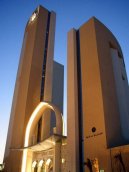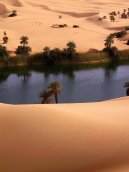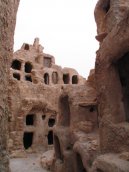| Introduction - Libya: |
Country | Libya |
|
Background | The Italians supplanted the Ottoman Turks from the area around Tripoli in 1911 and did not relinquish their hold until 1943 when defeated in World War II. Libya then passed to UN administration and achieved independence in 1951. Following a 1969 military coup, Col. Muammar Abu Minyar al-QADHAFI began to espouse his own political system, the Third Universal Theory. The system is a combination of socialism and Islam derived in part from tribal practices and is supposed to be implemented by the Libyan people themselves in a unique form of direct democracy. QADHAFI has always seen himself as a revolutionary and visionary leader. He used oil funds during the 1970s and 1980s to promote his ideology outside Libya, supporting subversives and terrorists abroad to hasten the end of Marxism and capitalism. In addition, beginning in 1973, he engaged in military operations in northern Chads Aozou Strip - to gain access to minerals and to use as a base of influence in Chadian politics - but was forced to retreat in 1987. UN sanctions in 1992 isolated QADHAFI politically following the downing of Pan AM Flight 103 over Lockerbie, Scotland. Libyan support for terrorism appeared to have decreased after the imposition of sanctions. During the 1990s, QADHAFI also began to rebuild his relationships with Europe. UN sanctions were suspended in April 1999 and finally lifted in September 2003 after Libya resolved the Lockerbie case. In December 2003, Libya announced that it had agreed to reveal and end its programs to develop weapons of mass destruction, and QADHAFI has made significant strides in normalizing relations with western nations since then. He has received various Western European leaders as well as many working-level and commercial delegations, and made his first trip to Western Europe in 15 years when he traveled to Brussels in April 2004. QADHAFI also resolved in 2004 some of the outstanding cases against his government for terrorist activities in the 1980s by compensating some families of victims of the Pan Am 103, French airliner UTA, and La Belle disco bombings. The US resumed full diplomatic relations with Libya in May 2006 and rescinded Libyas designation as a state sponsor of terrorism in June. |
|
|
|
| Location - Libya: |
Location | Northern Africa, bordering the Mediterranean Sea, between Egypt and Tunisia |
|
Geographic coordinates | 25 00 N, 17 00 E |
|
Map references | Africa |
|
Area | total: 1,759,540 sq km
land: 1,759,540 sq km
water: 0 sq km |
|
Area comparative | slightly larger than Alaska |
|
Land boundaries | total: 4,348 km
border countries: Algeria 982 km, Chad 1,055 km, Egypt 1,115 km, Niger 354 km, Sudan 383 km, Tunisia 459 km |
|
Coastline | 1,770 km |
|
Maritime claims | territorial sea: 12 nm
note: Gulf of Sidra closing line - 32 degrees, 30 minutes north
exclusive fishing zone: 62 nm |
|
Climate | Mediterranean along coast; dry, extreme desert interior |
|
Terrain | mostly barren, flat to undulating plains, plateaus, depressions |
|
Elevation extremes | lowest point: Sabkhat Ghuzayyil -47 m
highest point: Bikku Bitti 2,267 m |
|
Natural resources | petroleum, natural gas, gypsum |
|
Land use | arable land: 1.03%
permanent crops: 0.19%
other: 98.78% (2005) |
|
Irrigated land | 4,700 sq km (2003) |
|
Natural hazards | hot, dry, dust-laden ghibli is a southern wind lasting one to four days in spring and fall; dust storms, sandstorms |
|
Environment current issues | desertification; very limited natural fresh water resources; the Great Manmade River Project, the largest water development scheme in the world, is being built to bring water from large aquifers under the Sahara to coastal cities |
|
Environment international agreements | party to: Biodiversity, Climate Change, Climate Change-Kyoto Protocol, Desertification, Endangered Species, Hazardous Wastes, Marine Dumping, Ozone Layer Protection, Ship Pollution, Wetlands
signed, but not ratified: Law of the Sea |
|
Geography note | more than 90% of the country is desert or semidesert |
|
| People - Libya: |
Population | 6,036,914
note: includes 166,510 non-nationals (July 2007 est.) |
|
Age structure | 0-14 years: 33.4% (male 1,029,096/female 985,606)
15-64 years: 62.4% (male 1,940,287/female 1,827,429)
65 years and over: 4.2% (male 124,892/female 129,604) (2007 est.) |
|
Median age | total: 23.3 years
male: 23.4 years
female: 23.2 years (2007 est.) |
|
Population growth rate | 2.262% (2007 est.) |
|
Birth rate | 26.09 births/1,000 population (2007 est.) |
|
Death rate | 3.47 deaths/1,000 population (2007 est.) |
|
Net migration rate | 0 migrant(s)/1,000 population (2007 est.) |
|
Sex ratio | at birth: 1.05 male(s)/female
under 15 years: 1.044 male(s)/female
15-64 years: 1.062 male(s)/female
65 years and over: 0.964 male(s)/female
total population: 1.052 male(s)/female (2007 est.) |
|
Infant mortality rate | total: 22.82 deaths/1,000 live births
male: 25.07 deaths/1,000 live births
female: 20.47 deaths/1,000 live births (2007 est.) |
|
Life expectancy at birth | total population: 76.88 years
male: 74.64 years
female: 79.23 years (2007 est.) |
|
Total fertility rate | 3.21 children born/woman (2007 est.) |
|
Hiv aids adult prevalence rate | 0.3% (2001 est.) |
|
Hiv aids people living with hiv aids | 10,000 (2001 est.) |
|
Hiv aids deaths | NA |
|
Nationality | noun: Libyan(s)
adjective: Libyan |
|
Major infectious diseases | degree of risk: intermediate
food or waterborne diseases: bacterial diarrhea, hepatitis A, and typhoid fever
vectorborne diseases: may be a significant risk in some locations during the transmission season (typically April through October) (2007) |
|
Ethnic groups | Berber and Arab 97%, other 3% (includes Greeks, Maltese, Italians, Egyptians, Pakistanis, Turks, Indians, and Tunisians) |
|
Religions | Sunni Muslim 97%, other 3% |
|
Languages | Arabic, Italian, English, all are widely understood in the major cities |
|
Literacy | definition: age 15 and over can read and write
total population: 82.6%
male: 92.4%
female: 72% (2003 est.) |
|
| Government - Libya: |
Country name | conventional long form: Great Socialist Peoples Libyan Arab Jamahiriya
conventional short form: Libya
local long form: Al Jumahiriyah al Arabiyah al Libiyah ash Shabiyah al Ishtirakiyah al Uzma
local short form: none |
|
Government type | Jamahiriya (a state of the masses) in theory, governed by the populace through local councils; in practice, an authoritarian state |
|
Capital | name: Tripoli
geographic coordinates: 32 53 N, 13 10 E
time difference: UTC+2 (7 hours ahead of Washington, DC during Standard Time) |
|
Administrative divisions | 25 municipalities (baladiyat, singular - baladiyah); Ajdabiya, Al Aziziyah, Al Fatih, Al Jabal al Akhdar, Al Jufrah, Al Khums, Al Kufrah, An Nuqat al Khams, Ash Shati, Awbari, Az Zawiyah, Banghazi, Darnah, Ghadamis, Gharyan, Misratah, Murzuq, Sabha, Sawfajjin, Surt, Tarabulus, Tarhunah, Tubruq, Yafran, Zlitan; note - the 25 municipalities may have been replaced by 13 regions |
|
Independence | 24 December 1951 (from UN trusteeship) |
|
National holiday | Revolution Day, 1 September (1969) |
|
Constitution | none; note - following the September 1969 military overthrow of the Libyan government, the Revolutionary Command Council replaced the existing constitution with the Constitutional Proclamation in December 1969; in March 1977, Libya adopted the Declaration of the Establishment of the Peoples Authority |
|
Legal system | based on Italian and French civil law systems and Islamic law; separate religious courts; no constitutional provision for judicial review of legislative acts; has not accepted compulsory ICJ jurisdiction |
|
Suffrage | 18 years of age; universal and compulsory |
|
Executive branch | chief of state: Revolutionary Leader Col. Muammar Abu Minyar al-QADHAFI (since 1 September 1969); note - holds no official title, but is de facto chief of state
head of government: Secretary of the General Peoples Committee (Prime Minister) al-Baghdadi Ali al-MAHMUDI (since 5 March 2006)
cabinet: General Peoples Committee established by the General Peoples Congress
elections: national elections are indirect through a hierarchy of peoples committees; head of government elected by the General Peoples Congress; election last held March 2006 (next to be held NA)
election results: NA |
|
Legislative branch | unicameral General Peoples Congress (approximately 2,700 seats; members elected indirectly through a hierarchy of peoples committees) |
|
Judicial branch | Supreme Court |
|
Political parties and leaders | none |
|
Political pressure groups and leaders | various Arab nationalist movements with almost negligible memberships may be functioning clandestinely, as well as some Islamic elements; an anti-QADHAFI Libyan exile movement exists, primarily based in London, but has little influence |
|
International organization participation | ABEDA, AfDB, AFESD, AMF, AMU, AU, CAEU, COMESA, FAO, G-77, IAEA, IBRD, ICAO, ICRM, IDA, IDB, IFAD, IFC, IFRCS, ILO, IMF, IMO, IMSO, Interpol, IOC, IOM, IPU, ISO, ITSO, ITU, LAS, MIGA, NAM, OAPEC, OIC, OPCW, OPEC, PCA, UN, UNCTAD, UNESCO, UNIDO, UNWTO, UPU, WCL, WCO, WFTU, WHO, WIPO, WMO, WTO (observer) |
|
Diplomatic representation in the us | chief of mission: ambassador (vacant); Charge dAffaires Ali AUJALI
chancery: 2600 Virginia Avenue NW, Suite 705, Washington, DC 20037
telephone: [1] (202) 944-9601
FAX: [1] (202) 944-9060 |
|
Diplomatic representation from the us | chief of mission: Ambassador (vacant); Charge dAffaires ad Interim Charles O. CECIL
embassy: Corinthia Bab Africa Hotel, Souq At-Tlat Al-Qadim, Tripoli
mailing address: US Embassy, 8850 Tripoli Place, Washington, DC 20521-8850
telephone: [218] 21-335-1848 |
|
Flag description | plain green; green is the traditional color of Islam (the state religion) |
|
| Economy - Libya: |
Economy overview | The Libyan economy depends primarily upon revenues from the oil sector, which contribute about 95% of export earnings, about one-quarter of GDP, and 60% of public sector wages. Substantial revenues from the energy sector coupled with a small population give Libya one of the highest per capita GDPs in Africa, but little of this income flows down to the lower orders of society. Libyan officials in the past four years have made progress on economic reforms as part of a broader campaign to reintegrate the country into the international fold. This effort picked up steam after UN sanctions were lifted in September 2003 and as Libya announced in December 2003 that it would abandon programs to build weapons of mass destruction. Almost all US unilateral sanctions against Libya were removed in April 2004, helping Libya attract more foreign direct investment, mostly in the energy sector. Libyan oil and gas licensing rounds continue to draw high international interest; the National Oil Company set a goal of nearly doubling oil production to 3 billion bbl/day by 2010. Libya faces a long road ahead in liberalizing the socialist-oriented economy, but initial steps - including applying for WTO membership, reducing some subsidies, and announcing plans for privatization - are laying the groundwork for a transition to a more market-based economy. The non-oil manufacturing and construction sectors, which account for more than 20% of GDP, have expanded from processing mostly agricultural products to include the production of petrochemicals, iron, steel, and aluminum. Climatic conditions and poor soils severely limit agricultural output, and Libya imports about 75% of its food. Libyas primary agricultural water source remains the Great Manmade River Project, but significant resources are being invested in desalinization research to meet growing water demands. |
|
Gdp purchasing power parity | $72.68 billion (2006 est.) |
|
Gdp official exchange rate | $34.2 billion (2006 est.) |
|
Gdp real growth rate | 6.1% (2006 est.) |
|
Gdp per capita ppp | $12,300 (2006 est.) |
|
Gdp composition by sector | agriculture: 7.3%
industry: 51.3%
services: 41.4% (2006 est.) |
|
Labor force | 1.787 million (2006 est.) |
|
Labor force by occupation | agriculture: 17%
industry: 23%
services: 59% (2004 est.) |
|
Unemployment rate | 30% (2004 est.) |
|
Population below poverty line | 7.4% (2005 est.) |
|
Household income or consumption by percentage share | lowest 10%: NA%
highest 10%: NA% |
|
Inflation rate consumer prices | 3.1% (2006 est.) |
|
Investment gross fixed | 7.4% of GDP (2006 est.) |
|
Budget | revenues: $33.34 billion
expenditures: $19.3 billion; including capital expenditures of $5.6 billion (2006 est.) |
|
Public debt | 5.6% of GDP (2006 est.) |
|
Agriculture products | wheat, barley, olives, dates, citrus, vegetables, peanuts, soybeans; cattle |
|
Industries | petroleum, iron and steel, food processing, textiles, handicrafts, cement |
|
Industrial production growth rate | NA% |
|
Electricity production | 19.44 billion kWh (2004) |
|
Electricity consumption | 18.08 billion kWh (2004) |
|
Electricity exports | 0 kWh (2004) |
|
Electricity imports | 0 kWh (2004) |
|
Oil production | 1.72 million bbl/day (2006 est.) |
|
Oil consumption | 237,000 bbl/day (2004 est.) |
|
Oil exports | 1.326 million bbl/day (2004) |
|
Oil imports | 1,233 bbl/day (2004) |
|
Oil proved reserves | 42 billion bbl (2006 est.) |
|
Natural gas production | 8.06 billion cu m (2004 est.) |
|
Natural gas consumption | 5.93 billion cu m (2004 est.) |
|
Natural gas exports | 2.13 billion cu m (2004 est.) |
|
Natural gas imports | 0 cu m (2004 est.) |
|
Natural gas proved reserves | 1.472 trillion cu m (1 January 2005 est.) |
|
Current account balance | $14.5 billion (2006 est.) |
|
Exports | $37.02 billion f.o.b. (2006 est.) |
|
Exports commodities | crude oil, refined petroleum products, natural gas, chemicals |
|
Exports partners | Italy 37.4%, Germany 14.8%, Spain 7.8%, US 6.2%, France 5.6%, Turkey 5.4% (2006) |
|
Imports | $14.47 billion f.o.b. (2006 est.) |
|
Imports commodities | machinery, semi-finished goods, food, transport equipment, consumer products |
|
Imports partners | Italy 18.8%, Germany 7.8%, China 7.5%, Tunisia 6.2%, France 5.8%, Turkey 5.2%, South Korea 4.8%, US 4.6%, UK 4% (2006) |
|
Reserves of foreign exchange and gold | $57.48 billion (2006 est.) |
|
Debt external | $4.492 billion (2006 est.) |
|
Economic aid recipient | ODA, $18 million (2004 est.) |
|
Currency code | Libyan dinar (LYD) |
|
Exchange rates | Libyan dinars per US dollar - 1.3108 (2006), 1.3084 (2005), 1.305 (2004), 1.2929 (2003), 1.2707 (2002) |
|
| Communications - Libya: |
Fiscal year | calendar year |
|
Telephones main lines in use | 483,000 (2006) |
|
Telephones mobile cellular | 3.928 million (2006) |
|
Telephone system | general assessment: telecommunications system is being modernized; mobile cellular telephone system became operational in 1996
domestic: microwave radio relay, coaxial cable, cellular, tropospheric scatter, and a domestic satellite system with 14 earth stations
international: country code - 218; satellite earth stations - 4 Intelsat, NA Arabsat, and NA Intersputnik; submarine cables to France and Italy; microwave radio relay to Tunisia and Egypt; tropospheric scatter to Greece; participant in Medarabtel (1999) |
|
Radio broadcast stations | AM 16, FM 3, shortwave 3 (2001) |
|
Television broadcast stations | 12 (plus 1 repeater) (1999) |
|
Internet country code | .ly |
|
Internet hosts | 31 (2006) |
|
Internet users | 232,000 (2005) |
|
| Transportation - Libya: |
Airports | 141 (2006) |
|
Airports with paved runways | total: 60
over 3,047 m: 23
2,438 to 3,047 m: 6
1,524 to 2,437 m: 23
914 to 1,523 m: 6
under 914 m: 2 (2006) |
|
Airports with unpaved runways | total: 81
over 3,047 m: 5
2,438 to 3,047 m: 2
1,524 to 2,437 m: 15
914 to 1,523 m: 41
under 914 m: 18 (2006) |
|
Heliports | 2 (2006) |
|
Pipelines | condensate 882 km; gas 3,481 km; oil 6,916 km (2006) |
|
Railways | 0 km
note: Libya is working on seven lines totaling 2,757 km of 1.435-m gauge track; it hopes to have trains running by 2008 (2006) |
|
Roadways | total: 83,200 km
paved: 47,590 km
unpaved: 35,610 km (1999) |
|
Merchant marine | total: 18 ships (1000 GRT or over) 86,034 GRT/89,820 DWT
by type: cargo 10, liquefied gas 3, passenger/cargo 1, petroleum tanker 2, roll on/roll off 2
foreign-owned: 4 (Kuwait 1, Norway 1, Turkey 2) (2006) |
|
Ports and terminals | As Sidrah, Az Zuwaytinah, Marsa al Burayqah, Ras Lanuf, Tripoli, Zawiyah |
|
| Military - Libya: |
Military branches | Armed Peoples on Duty (APOD, Army), Libyan Arab Navy, Libyan Arab Air Force (Al-Quwwat al-Jawwiya al-Jamahiriya al-Arabia al-Libyya, LAAF) (2007) |
|
Military service age and obligation | 17 years of age (2004) |
|
Manpower available for military service | males age 17-49: 1,505,675
females age 17-49: 1,429,152 (2005 est.) |
|
Manpower fit for military service | males age 17-49: 1,291,624
females age 17-49: 1,230,824 (2005 est.) |
|
Manpower reaching military service age annually | males age 18-49: 62,034
females age 17-49: 59,533 (2005 est.) |
|
Refugees and internally displaced persons | refugees (country of origin): 8,873 (Palestinian Territories) (2006) |
|
Military expenditures percent of gdp | 3.9% (2005 est.) |
|
Disputes international | Libya has claimed more than 32,000 sq km in southeastern Algeria and about 25,000 sq km in the Tommo region of Niger in a currently dormant dispute; various Chadian rebels from the Aozou region reside in southern Libya |
|
This page was last updated on 16 September, 2007



